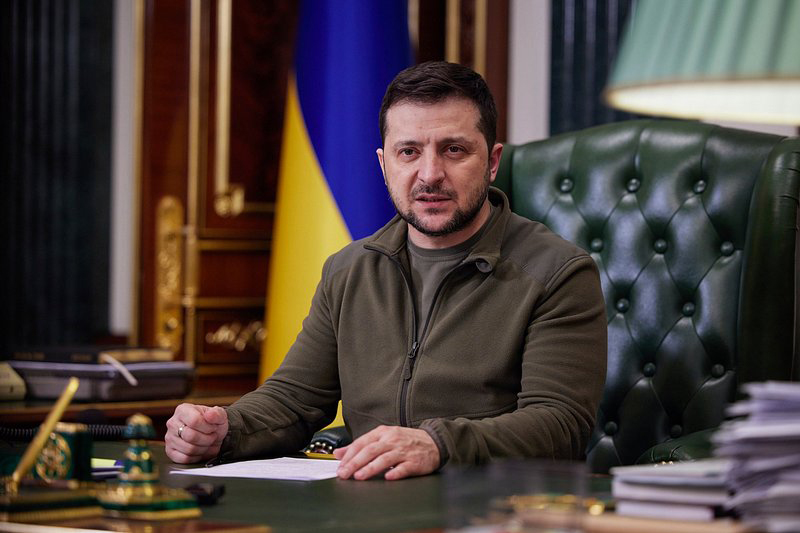Huge Ukrainian Losses Changing Outlook

On June 15-16, Switzerland hosted a global Peace Summit for Ukraine. Russia was not invited and because of that many countries declined to attend. The absent list included China, India, and many other great powers. Volodymyr Zelensky’s strategy was evidently to get the world to condemn Russia and force a peace plan on Russia. Nevertheless, 86 of 193 United Nations member nations and four international organizations sent representatives. Seventy-eight nations and the four international organizations signed the final communication. Nine more states indicated their approval of the communication after the event. Those rejecting the invitation were particularly numerous in the “Global South,” where US influence in waning and public opinion is no longer favorable to the US and NATO narrative about the Ukraine War. Zelensky’s 10 point peace plan was more propaganda than a reasonable framework for negotiated peace. Zelensky undoubtedly also raised much needed additional funds to operate the Ukrainian government and relieve military weapons and munitions shortages.
However, on June 27, President Zelensky told reporters in Brussels that a detailed action plan should be prepared to consider at Ukraine's Second Peace Summit over the next few months. Zelensky told the reporters:
“Over the next few months, a detailed action plan should be prepared for consideration at the second Peace Summit. Now we need to develop a detailed plan of detailed steps regarding all the crises that Putin's war has brought to our land.”
Note that the second part of this paragraph below shows a sense of urgency, and contrary to Zelensky’s usual balderdash about Ukraine winning the war, an admission of heavy Ukrainian casualties:
“Within months we have to make this plan, we don't have much time. We have many wounded and killed, both military and civilians. So we don't want this war to last for years. Therefore, we have to prepare this plan and put it on the negotiating table at the second Peace Summit."
The quote above is on the 35-second YouTube video below”
https://www.youtube.com/watch?v=J9X58JFrZtg
According to former Trump defense adviser, Col. Douglas Macgregor (USA ret.), the consensus of his intelligence contacts in Europe, Ukraine, and elsewhere indicate the Ukrainians have lost 600,000 or more military killed-in-action (KIA) since the beginning of the war. Russian KIA is probably less than 50,000.
According to UN data and a projection of Reuters data for the last five months, Ukrainian civilian deaths are about 12,000, which is a surprisingly low figure for the military intensity involved. This indicates that Putin’s instruction to minimize civilian casualties has been relatively successful.
According to Statista, at least 6.5 million refugees have fled Ukraine as of February 2024. More went to Russia than any other country, somewhere between 1.2 and 2.0 million. The refugee problem has badly damaged Ukraine’s economy and contributed to the manpower shortage already severe because of high casualties.
In addition to 600,000 dead, there are likely at least 600,000 too seriously wounded to return to duty, many of them amputees, which are terribly common among artillery casualties. The Russians have conservatively an 8-10 to one advantage in artillery weapons and munitions.
Ukraine is a culturally and linguistically divided country. Only about 60 percent of the populations within its 1991 borders consider Ukrainian their native language. About 18 percent consider Russian their native language, and approximately 22 percent consider both Russian and Ukrainian their native language. Most of Ukraine’s primarily Ukrainian speakers also speak Russian as a second language, and many of these prefer Russian for daily business. Both Russian and Ukrainian are East Slavic languages and are much alike. Moreover, Orthodox Christianity is common to most Ukrainians and Russians. Even Ukrainian and Russian DNA have much in common. Millions of Ukrainians served in the Soviet Red Army during World War II, which they refer to as the Great Patriotic War.
Before the US and its closest NATO allies determined to make Ukraine a Western military and economic bulwark against the Russian Federation, most Russians and Ukrainians considered themselves Slavic-Orthodox brothers. A substantial majority of Ukrainians had no desire for Ukraine to be part of NATO. Only a fairly small minority of 10 to 15 percent located mostly in Western Ukraine thought differently. Some of these had an unfortunate history of association with Nazi Germany, which promised them independence from the Soviet Union early in World War II.
In 1991, when the Soviet Union collapsed, the Russian Federation wanted to pursue economic and political freedom and become cultural friends and allies with the West. But too many in US leadership were primarily interested in maintaining Amerca’s position as the unchallenged hegemon of economic and military power. A benevolent American exceptionalism drifted more and more toward Pax Americana military, economic, financial, and cultural dominance by any means, including CIA regime changes.
The Orange Revolution in 2003-4 was the first CIA interference in Ukrainian democracy, overturning the election of pro-neutral Ukrainian Prime Minister Viktor Yanukovych to the Presidency. When this failed with the election of Yanukovych to the presidency in 2010, the US spent the next several years, according to State Department Under Secretary Victoria Nuland, investing $5 billion “democratizing” Ukraine, resulting in the violent US backed Maidan Revolution and unlawful removal of Yanukovych from office, causing him to flee the country. US Vice President Joe Biden, Victoria Nuland, and now National Security Advisor Jake Sullivan had decisive high-level parts in this coup.
Predominantly Russian Crimea with its major Russian Black Sea naval base at Sevastopol was outraged by the coup and violence against Russian ethnics. Crimea was lost almost immediately to Ukraine when it rejoined Russia, after an overwhelming referendum. More than 90 percent of Ukrainian troops in Crimea went over to the Russians. There was no fighting in Crimea.
The Unlawful coup and violence resulted in a Civil War with the Ukrainian Army trying to crush secessionist movements and militias in predominantly Russian-speaking states in southeastern Ukraine, especially in the Donbass states of Donetsk and Lugansk. The Ukrainian government soon turned this into an anti-terrorist campaign that was really ethnic cleansing of Russian ethnic minorities. Many Ukrainian soldiers and whole units refused this war and ethnic cleansing against their ethnic and religious brothers. Entire Ukrainian units with all their weapons, munitions, and supplies went over to the Donbass militias. The Ukrainian Army was in danger of defeat, when the 2015 Minsk accords resulted in a cease fire and agreement to hold elections for the semi-autonomy for the Donetsk and Lugansk republics and to mandate complete civil, language, religious, and cultural rights for Russian ethnics. Ukraine, however, with the tacit approval of the US, UK, and France never intended to institute the Minsk agreements. They only wanted time to build up the Ukrainian Army to retake Crimea. About 14,000 people died in the Civil War. About 10,000 of them were Russian-speaking civilians. Ukrainian artillery continued to pound civilian areas of Donetsk and Lugansk into 2022.
Zelensky, an extremely popular Jewish comedian and actor, was elected President of Ukraine in May 2019, with 75 percent of the vote, running on a peace platform and promising to implement the Minsk agreements and move toward better relations with Russia. He was largely financed, however, by Igor Kolomoisky, a Jewish banking and media oligarch and politician, who had also financed several extremist organizations supporting the Maidan Revolution, including the terrorist-associated Azov battalions. Zelensky turned against Kolomoisky in 2020, and Kolomoisky was arrested by the Ukrainian Security Service (SBU) for bank fraud and other crimes in September 2023. Kolomoisky’s alleged fraud and money-laundering schemes also extended to the US and UK.
Shortly after Zelensky’s 2019 election as a peace candidate, Dmytro Yarosh, founder of the paramilitary Right Sector and founder and commander of the paramilitary Ukrainian Volunteer Army stated that Zelensky’s life was in danger if he implemented his peace promises. Yarosh is currently a Vice Prime Minister of Ukraine. Furthermore, Zelensky found no support for his peace plans with the US and UK, who wanted to make Ukraine an armed anti-Russian bastion.
However, within two weeks after the beginning of the war on February 24, 2022, Zelensky tried three times to arrange peace talks through Belarus, Israel, and then through Turkey on terms also acceptable to the Russians. These plans, however, were crushed by the US and UK, who wanted to continue the war against Russia. The already-signed Turkish-aided peace agreement was dissuaded by a visit from British Prime Minister Boris Johnson on April 9, 2022. From then on, Zelensky claimed he could never negotiate with Vladimir Putin, who he branded a “war criminal.”
Beginning in mid-February 2022, the Ukrainians began escalating their artillery attacks and positioning greater troop strength in the Donbass region, threatening Donetsk City. By February 22, they increased their artillery volume ten-fold, provoking Putin to take military action on February 24 to save Russian civilian lives and deter Ukrainian capture of major cities in Donetsk and Lugansk.
Meanwhile, the Ukrainians found their most effective troops, with little compunction for killing Russians or Ukrainian dissenters, were those from Western Ukraine who had supported the Maidan Revolution. They tended to be radical politically and to harbor ethnic-centered ideology, which translated into an ethnically pure Ukrainian ideal. Although Ukrainian, they have a passion for Germanic Runic symbolism. Many of these came from the Right Sector of the Svoboda Party and the Azov battalions, who have a reputation for radicalism, brutality, and terrorism. The Azov units are attached to the Interior Ministry and primarily associated with brutish internal security but have earned the reputation of being the most dependable combat units. The Azov units and other radical militias are generally associated with internal security, ideological enforcement, and covert intelligence actions.
The sentiment of most Ukrainians is not radical and not inclined to hate or fight Russians based on disputable propaganda or political hyper ventilation.
In early December 2021, just before the February 2022 Russian intervention, the Kyiv International Institute of Sociology (KIIS) surveyed Ukrainian willingness to resist a Russian invasion. Barely more than 50 percent indicated they would resist in any way, and only 17 percent would be willing to take up arms. This 17 percent was most common in the 50-59 age group. The least willing were those 18-29 years of age, usually the backbone of any army. The highly inflated rhetoric about fighting to the last Ukrainian is Western self-deception and dulled moral compass.
Another indication that Ukrainians have some moral objection to killing their bother Orthodox Slavs for some pumped up political and moral incongruity comes from an October 2018 report by the Ukrainian Chief Military Prosecutor. According to the report, 2,700 Ukrainian solders had died in the Donbass during the preceding four years. Of these, 615 or nearly 23 percent were suicides. Alao in the October-November 2017 report, 70 percent of conscripts did not show up.
In 2024, Ukrainian military recruiting amounts to taking people by brute force on the street. Men and boys dare not go out for groceries. Many have emigrated. The average Ukrainian soldier is 43.
Ukraine cannot successfully recruit or forcibly draft enough men to replace rapidly escalating casualties. Has Zelensky realized that he must negotiate with the Russians to save what is left of Ukraine?
The justifying narrative for the Ukraine War is false. Most reported Ukrainian victories are either disinformation or exaggeration. Most of the Western media cannot be depended upon for truth. Too few in Congress have the discernment to see the truth or the courage to say it loudly and insist on acting on it. We need to quit demonizing foreign leaders; it blinds us to important facts, multiplies the risk of war, and endangers tens of millions of lives.
Trump is right. We need to stop the killing, and bullying or bluffing opponents leads to bigger war, even nuclear war, not peace. The Biden regime must go.









 Mike Scruggs is the author of two books: The Un-Civil War: Shattering the Historical Myths; and Lessons from the Vietnam War: Truths the Media Never Told You, and over 600 articles on military history, national security, intelligent design, genealogical genetics, immigration, current political affairs, Islam, and the Middle East.
Mike Scruggs is the author of two books: The Un-Civil War: Shattering the Historical Myths; and Lessons from the Vietnam War: Truths the Media Never Told You, and over 600 articles on military history, national security, intelligent design, genealogical genetics, immigration, current political affairs, Islam, and the Middle East. 


